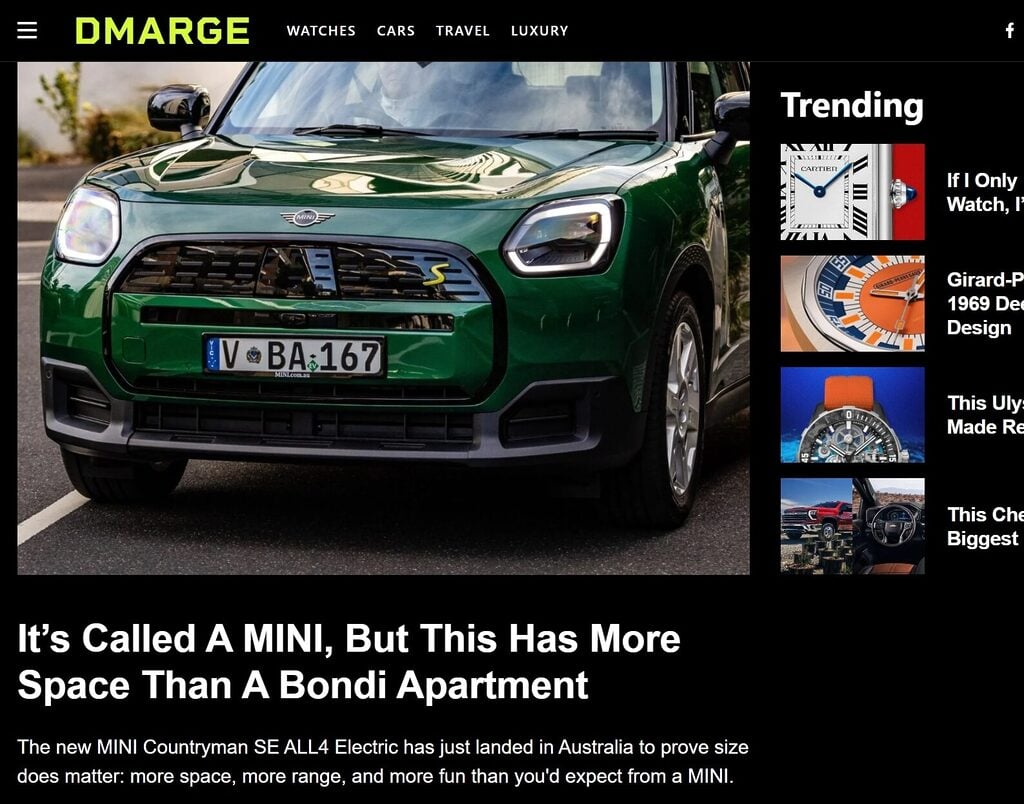dmarge.com – I’ve never seen this many red-flags rolled into a single site
I read the full article on Medium, and oh my, this sets the bar for entitlement. And while absolutely real, yes, owners like this exist, I’ve met a few over the years.
But not all owners are created equal, not even close!

I’ve learned to vet and qualify owners who try to hire me within the first 30-60 minutes of a meeting. As of 2025, my acceptance rate is only 14%, and this number largely reflects the quality of owners requesting help.
A business owners’ decisions and actions are the primary driving factor in their success.
In late 2023, one of Australia’s longest-running men’s lifestyle publications (my business) was essentially thrown out of Google.
To start, clearly NOT thrown out.

November 2021 Spam Update – warning
Spam updates target sites that don’t follow the webmaster guidelines. Sites impacted by these updates may be seeking short term gains while ignoring best practices.
October 2022 Spam Update – NUKED
Spam updates target sites that don’t follow the webmaster guidelines. Sites impacted by these updates may be seeking short term gains while ignoring best practices. This update was completed on October 21st.
So we know, straight away, red flags are abundantly clear, and an owner claiming he and his business are church nuns.

We weren’t publishing spam or gaming the system. We were doing what we had always done: creating original content with a 10-person editorial team focused on relevance and tone, watches, cars, food, travel, and more.
You were doing exactly this, in fact around 2022-2023 a lot of businesses fell into the same pattern.
Do as little as possible, and consistently publish low-quality articles with barely enough text to qualify for an AI overview today. And while it worked for a time, this is the definition of short-term gains, while ignoring best practices.
And it goes without saying, just because something works (for a time), doesn’t mean it’s actually good.
The moment the system and its ability to qualify content improved, it became abundantly evident what’s what, and you lost your shirt and your shit all at once.
Oct. 22 is the exact date this company should have hired a data-driven SEO. Of course, this isn’t even the end of the story; it’s just the beginning.
And by hire, I mean, not try to do it yourself!
March 2023 Core Update – slapped around again
Core updates involve large changes to Google’s algorithm aimed to make the results better. They’re generally focused on E-E-A-T or Experience, Expertise, Authoritativeness, and Trustworthiness. These updates can cause significant shifts in ranking.
August 2023 Core Update – and again
Core updates involve large changes to Google’s algorithm aimed to make the results better. They’re generally focused on E-E-A-T or Experience, Expertise, Authoritativeness, and Trustworthiness. These updates can cause significant shifts in ranking.
August 2024 Core Update – and again
This update is designed to improve the quality of search results by showing more content that people find genuinely useful and less content that feels like it was made just to perform well on Search. This latest update takes into account the feedback Google heard from some creators and others over the past few months. They aim to connect people with a range of high quality sites, including small or independent sites that are creating useful, original content, when relevant to users’ searches. This update also aims to better capture improvements that sites may have made, so Google can continue to show the best of the web.
March 2025 Core Update – and again
Core updates involve large changes to Google’s algorithm aimed to make the results better. This is a regular update designed to better surface relevant, satisfying content for searchers from all types of sites. These updates can cause significant shifts in ranking.
Technical Fuckup – hack? something dumb?
Yet another red flag.

Since this is the only technical segment for this article, I’ll add the ridiculous, endless-scrolling articles, likely yet another hack.
Next Significant Red Flag, on top of the 6+ already noted above.
Like many others, we turned to the SEO world to make sense of it all. We followed every update from John Mueller, waited for clarification from Danny Sullivan, listened to Barry Adams telling publishers to cut harder, and absorbed Glenn Gabe’s detailed breakdowns of visibility drops. We even approached Brodie Clark, which was not a cheap option. Did we still consider it? Absofuckinglutely we did. You’ll do anything to save your firstborn — even if it has red hair.
This is a cluster fuck in a cluster fuck, and I’m not even factoring in the owner, his entitlement, ego, and what I’m sure amounted to endless arguements about what other businesses are doing.
So we tried to fix it. Not with tricks or shortcuts. But by going line by line through our twelve thousand article archive. We noindexed thin content. Deleted dead categories. Removed tags. Hired real experts. Rebuilt the editorial structure from scratch. And we spent thousands.
Red-flag, after red-flag!
- caught by spam update not once, but twice, anyone taking, ‘not with tricks or shortcuts’ at face value, I’m not. I hear this shit far too often.
- noindexed doesn’t do shit, process for handling content
- delete (410), hell not even 404
- redirect (301), merge relevant when possible
- noindex, is dead last and reserved for one reason ONLY
- low quality, with high traffic and revenue
- often assocaited with other traffic channels
- Hired real experts, expensive and completely and utterly useless
- likely caused even more issues
- at best your a blog, quality content, decent RPMs
- at worse your a news outlet, shit content, crap RPMs
- all of the above are powered by OPINION, not EXPERTS
Category, Tags, and Basic structure have been default requirements for over a decade.
Over two and a half years (longer actually) and countless hours, we did everything we were supposed to do. It didn’t work. In fact, we lost even more traffic and continue to lose it today.
No shit. A single decision can change the entire course of a business. You made hundreds, many of which amplified issues rather than resolving them.
Honestly, the only thing I see here is how to stack bad decisions, one after another. Owners, you have all the power, make all the decisions, and are the primary determining factor in long-term success.
Lily Ray’s Recommendations:
- Do not delete categories. Demote them in navigation or move them to the footer or sitemap > nope remove (410)
- Make categories more granular, not broader > yes, no shit
- Audit every URL using GA, GSC, backlinks, and traffic source data > yes
- Strengthen internal linking using Link Whisperer or InLinks > meh, default requirement
- Add actual text to video-heavy pages < no such thing as video heavy pages, this shit shouldn’t even exist
- Submit each Discover-style section to Google Publisher Center separately < not even ON THE TABLE
- Remove or isolate NSFW content, which could be dragging down the entire domain > default
- Consider testing a new subdomain just for Discover > useless, time suck
- If Discover shows signs of life on any topic, double down and publish two or three related posts immediately > why we still talking about discover
- You may be covering too many topics. > you are
Note on Discover: I’ve never witnessed a site generate Discover traffic that was decimated by multiple core/spam updates.
That last point somewhat contradicted her first recommendation but it was still worth investigating. If GQ, Men’s Health or Esquire can cover everything, why can’t we?
The moment you compare your business to another, you’ve lost. You’re not GQ, Men’s Health, or Esquire, and you cannot cover everything.
To be any of these companies, you’d need to spend millions annually to produce the content required to sustain and rank these categories, yet you’re crying about 200k, and you believe you’re on the same playing field as these companies.
GQ – 41,810 posts, 2.1m organic traffic, 50.22 per post
Men’s Health – 73,205 posts, 9.3m organic traffic, 127.04 per post (this)
Esquire – 93,275 posts, 4.3m organic traffic, 46.10 per post
Dmarge – 3,501 posts, 14,182 organic traffic, 4.05 per post
Also, I’ve never heard of Dmarge, while the others are lifestyle staples.
Purged what we assumed was thin or low quality, but probably wasn’t
We started with word count. Articles under two hundred words are not always low quality, but they often lack depth. Thousands were noindexed, converted to draft, or deleted. It was not about hitting a specific number. We just wanted to avoid anything Google might label unhelpful.
Delete, the fact noindexed is even mentioned here is an issue
How about what people might label unhelpful, I mean, all of this, circles back to the audience, not Google.
The fact that this is even presented as “wanted to avoid anything Google might label unhelpful” is another red flag in itself.
Remember that over 15 years, we have interviewed some awe-inspiring people—doctors, CEOs, athletes, you name it. It’s not like our publication was a content farm on the outskirts of Mumbai. We even had a print magazine, 100,000 email subscribers, and a few hundred thousand social followers.
By had, I presume past tense.
While plenty of sites have loads of high-quality content, that doesn’t erase the fact that they also have an unreal amount of crap content. As Google states, sites impacted by these updates may seek short-term gains while ignoring best practices.
Next we tackled stories built around embedded media. TikToks, YouTube videos, tweets. About thirteen hundred of them.
Never should have existed, embedded media, and audiences are built on their respective platforms.
These stories often had one or two paragraphs of text and then someone else’s content. We removed the embeds, rewrote the copy, and rebuilt them as original articles.
Articles rewritten and rebuilt become main content, embeds should not have been removed, but deprioritized as supporting content. This would be an example of high-quality content for people. Yet once again, I believe you were focused on Google, rather than your audience.
We looked at stories padded with quotes. Common practice in newsrooms, but risky when there is little original value. Articles based on Reddit threads, press releases, or celebrity statements were either rewritten or deleted. It didn’t matter that other publishers do it. We are not other publishers.
The definition of spam. This business operated as a news site and a blog, contributing to its downfall.
Add in the discovery questions answered by Lily, and I have no doubt she was explicitly asked about this; otherwise, why answer.
If you’re chasing blog news, you’ll die. You’re not a news outlet, and you can’t compete with news outlets. By attempting to achieve this, you kill your blog, devalue your magazine, devalue your email, and ultimately, your brand over time.
Again, as Google states, chasing traffic.
Every surviving article was reviewed:
- Internal links were added to strong-performing articles
- External links were added to brands, research, or original sources
- More than one image was included
- Inline related reads were added to help signal topical relevance
It was manual. It was obsessive. It was slow. And ultimately? No visible impact.
Well, that’s cool, but most, if not all, of this is just the basic default. Once again, the above sounds more like hacks than genuine effort.
Every surviving article should have been significantly improved from TOP to BOTTOM, which amounts to main content, what you actually rank for.
The rest of this is just maintenance and supporting content.
1. internal/external links, general
2. more than one image, so two then, low effort
3. related reads, supporting content, nothing more
None of this significantly improved content quality, maybe you gave it a 10-20% boost and were hoping for a hail mary.
We deleted all tag pages across the site. Not noindexed. Deleted. They weren’t ranking. They weren’t being crawled. And they weren’t being used. The impact on traffic? Zero. This confirmed our long standing belief that tag pages were just leftover clutter from WordPress.
Something that’s been done for 10+ years
We brought in real subject matter experts. Fashion stylists. Car journalists like Mike Sinclair. Watch experts like Jamie Weiss and Felix Scholz. Grooming specialists, hairdressers, GPs and plastic surgeons. We created bios. Cross-linked their profiles. Gave them proper credit. Interviewed them regularly and ensured their stories were high quality. Based on the guidelines, this should have helped. But it didn’t. The content performed the same.
Absolutely hilarious. Of course it didn’t. What you needed were enthusiasts’ opinions, not experts’. I’m honestly starting to wonder if anyone actually does any work in this industry.
And even then, these author profiles are a joke. The fact you burned through countless experts and are still using:
https://www.dmarge.com/author/jamie-weiss
1. default/generic author links in WordPress
2. author profiles, with zero depth, and two fucking paragraphs
3. this is unreal
Taking this further, everything about oriented is trash.
https://dmarge.com/about-dmarge
You actually write about the business and brand, and establish a CLEAR purpose.
This is also a joke!
Our mission is to be all about what matters to men.
So, everything and subsequently nothing. This about page was put together for Google. While all relevant, your editorial guidelines, terms and conditions, and socials are basically footnotes on about pages in terms of value.
And for all the experts in the world, somehow you couldn’t figure out the basics!
/about/ < laser focused on biz/brand, clearly define purpose, content you cover, why you cover it, make your MISSION known to the WORLD
/about/full-name/ < real author profiles, make an effort, you know the kind of effort your kid invests into something they love
Breadcrumbs, that tied everything together, I mean seriously.
Home > Demarge > Luc Lastname
> links/connects authors to BRAND
Home > Demarge
> links/connects brand to BUSINESS
Back to your shit show with EEAT!
About the only thing you’d require EEAT for is men’s health, which you removed. And even then, I’d still push you to focus on OPINION.
DMARGE is a leading lifestyle publisher delivering breaking news and expert advice across style, travel, luxury, cars and watches.
NOTHING LISTED HERE REQUIRES EEAT
As a lifestyle business, your entire business should be based on opinion for REAL people. The experts can piss off and go write content on Car and Driver for hardcore car enthusiasts.
Your audience wants real-life opinions. A lifestyle business that captures the genuine, everyday love for something without implying professional or expert-level knowledge.
I’m flagging this as monumental fail.
Despite Lily’s original advice and our own instincts, we completely deleted all content verticals, such as style, sport, grooming, food, and entertainment. Later, she suggested that we may be covering too many topics. All lifestyle websites are broad. That is the nature of the format.
False, once again mentioning ALL lifestyle websites. I worked with an owner focused on watches and nothing else. He loves this, and his work is unparalleled. I’m now a regular user and own two watches.
What is this shit show?
Post title: It’s Called A MINI, But This Has More Space Than A Bondi Apartment
Google title: MINI Countryman SE ALL4: The Biggest SUV Surprise Of 2025
https://dmarge.com/cars/mini-countryman-se-all4-review
How to fuck up Intent, and rank for nothing, without even trying. If all of the articles are like this, no wonder.
I’m going to assume, based on the URL, you intend to rank for “Mini Countryman SE ALL4 Review”, so I have no clue what on earth you were trying to achieve with
It’s Called A MINI, But This Has More Space Than A Bondi Apartment
> has absolutely nothing to do with REVIEW
MINI Countryman SE ALL4: The Biggest SUV Surprise Of 2025
> same, I mean seriously
Cheap news, chasing discover traffic? Honestly, the above makes no sense.
This is basic shit. The fact that you’re getting annihilated on intent is mind-blowing. Here are the top-ranking options for the intent you want to rank for.

Our thinking was based on the Google Search documentation leak that mentioned SiteFocus. We assumed being too broad was hurting us, so we narrowed our scope. The result? We lost even more traffic due to the disappearance of long-tail content. No recovery followed.
SiteFocus is critical, but it’s more like a defined purpose than a dedicated SiteFocus, which is non-existent.
DMARGE – What Matters To Men
Site Purpose > What Matters to Men
In summary, everything, hell, even babies.
Get real.
Jesus, take Men’s Health
Men’s Health – Fitness, Nutrition, Health, Sex, Style & Weight Loss
Site Purpose > Clear as day, and in some cases requires EEAT
One of the easiest ways to grow long-term. Pick one category, master it, and cover every topic. Once you complete this category, start a shoulder category that is closely related. Remember that you’re now managing category 1, while scaling category 2, and as category two peaks, you start category 3, and still have to manage 1 and 2.
As you scale, your team scales, and by the time you reach category three, you have three pods with one editor and four writers each. (example)
The most frustrating part? While we were cutting carefully written journalism, Google Discover was filled with spam. AI generated content. Clickbait. Content farms with fake author profiles. Image heavy junk with no editorial value. It completely undermined the promise of helpful content. It proved we were not even playing the right game.
As I noted above, this is precisely what discovery and news are. Carefully written journalism has no place in discovery or news, and doing both is impossible.
This likely explains the horrific post title and Google titlefor what was intended as a quality review, chasing discover, and subsequently failing everything.
We had a large health section focused on fitness and mental health for men. We were proud of it. Trainers and doctors contributed. But we were unsure if this was holding us back. So we deindexed and removed the entire health section. Two thousand articles. A real loss. Especially since men need more guidance in this area, not less.
Cool. Too bad your clearly defined purpose was not aligned with health. If men truly need more guidance on this area, you should have started a separate site with a clearly defined purpose, moved the 2,000 articles, and diversified.
NSFW is a pretty obvious one. However, we were clutching at straws and desperate, so we systematically removed every instance of swearing (like sh*t or cr*ap). Even words that could be slightly flagged as ‘inappropriate’ got rewritten. Thousands of articles were edited. Manually. We then wondered if fitness articles with shirtless guys working out could be an issue, so the entire fitness category was edited.
Likely helped more than it hurt. This sounds like a segment of the site that was actually real, and from what I gather, likely rewritten by MORE experts.
The sheer amount of wondering, assumptions, and ultimately owner-executed decisions is unreal.
You can see just how far we were willing to take this. I was willing to kill years of work just to find the smoking gun.
The smoking gun, the owner. I’ve seen a single poor decision tank million-dollar companies. In this case, I’ve already lost count.
Let’s be clear, this is complete nonsense. Those vague video chats John Mueller does about whether ads impact rankings are meaningless. Glenn Gabe also mentioned this too.
If your site is loaded with pop-ups, autoplay videos, and a terrible user experience, you can still rank just fine. It doesn’t matter whether you have five or fifty per page. Just look at the Daily Mail or Daily Express. Those chaotic, ad-choked messes rank everywhere and print money doing it. We became so cautious that we all but removed ads from the site. Like wtf.
We were willing to throw away revenue to try and find a solution to the problem. So much so that today we earn about 3-%5% of what we once did on programmatic ads. Them’s the brakes when you build a house on quicksand.
More bad decisions. Everything I’ve found, tested, and collected data-wise indicates that user experience, engagement, and satisfaction are paramount. Users, real users, actually have to like what you’re doing.
The moment you stop comparing your business to sites with 5m plus organic traffic, you’ll find yourself in a much better headspace.
express.co.uk 7.4m organic traffic, 0.5m posts
dailymail.co.uk 23.6m organic traffic, 1m posts
Ego? Something else? Who compares their tiny site to titans, expecting to find answers to anything.
They, by they, I mean large sites, get away with things you’d never manage in a million years. And the fact that you think you operate on the same playing field as, say, Woolworths, IGA, etc., says a lot about you as a business owner.
We were told by Lily that Google couldn’t properly identify our site’s content themes because we didn’t include categories in our URL structure.
It’s far more likely that Google was so fucking confused by INTENT, even a clean URL structure wouldn’t help.
Every post has multiple personality disorders, er, mixed intent.
i.e. www.dmarge.com/watches/rolex-daytona-buyers-guide rather than the old one parent structure www.dmarge.com/rolex-daytona-buyers-guide
I see now you’ve fucked with this consistently.
https://dmarge.com/watches/rolex-daytona-watch
funny thing, the link above was far more intentful and actually matched the intent of the article: Rolex Daytona Buyers Guide: Everything You Need To Know
> Everything you need to know is just junk, post title spam
But once again,
URL: www.dmarge.com/watches/rolex-daytona-buyers-guide
Post title: Rolex Daytona Buyers Guide
Google Title: Rolex Daytona Buyers Guide for Enthusiasts
So we rebuilt the entire permalink setup to include subdirectories for every article — watches, cars, travel, business, and so on — to give Google a clearer content hierarchy. It was a big change that created thousands of redirects across the site. The result? Absolutely zero impact. This was 18 months ago too. No dice.
Again, more than likely a monumental intent issue, which you absolutely can’t fake, and everything you ADD that is not aligned with intent, detracts from it, making it nearly impossible to rank for anything.
It won’t surprise you, but my analysis of other websites was exhaustive. What was most interesting was the inconsistency between seemingly similar sites to ours and the difference in visibility across all Google channels.
Waste of time. The fact you cannot even identify the root cause of your own site, data in hand, with an army of professionals, how exactly were you expecting to do the SAME with external sites, and NO data…
This so-called inconsistency you refer to is often known as Variables. The variables are dynamic and weighted, and as a result, they are fluid site to site.
Whatever reason you come up with for X, Y, Z, site ranking, not ranking, etc., is flawed by default and almost guaranteed to result in further negative actions internally.
This led me down the backlink path; however, nothing stood out. We had a 15-year backlink profile with Bloomberg, CNN, The Guardian, Business Insider, and Wikipedia linking to many of our stories. Sure, there was a fair share of sh*t links in there, but everyone has those. We had even tried the disavow path, but that proved to be useless.
The disavow path is more often than not negative rather than positive. No different than the above, even by experts, disavows are still assumptions about what is or is not a positive contributor.
My only conclusion here is maybe too much affiliate-focused content, which is why we removed every ‘Best…’ story we had (there was a lot btw — most products we purchased and reviewed in the studio. Again, trial and error. Mostly errors, and things that just didn’t make sense.
At best, no more than 20% of your site should be affiliate-focused. And based on a lifestyle blog, this would again be opinion-based.
We genuinely believed technical SEO would be a game-changer. Every year, we invested around $60,000 to $70,000 into development, testing, and benchmarking against sites that were thriving. We scrutinised everything from permalink structures, server configurations, Core Web Vitals, whether using www made a difference, and dozens of other technical factors. We double-checked, triple-checked, ran audits, optimised crawlability, and made the site as fast and clean as possible. It should have been a textbook example of technical best practice. But once again, it made no difference.
I’m also a server engineer and own a hosting company; this part is hilarious. If you had done the same internally and consistently improved quarter to quarter, you likely would have gained something. And I say this because THIS unrelenting internal pursuit benefits your AUDIENCE.
Meanwhile, while you’re tanking, you’re simply trying to reverse engineer what, how, and why sites rank. And in many ways, as an owner, you’re playing the wrong game entirely.
Investing 60-70k annually, while throwing up SiteGround performance metrics.


Yet another monumental red flag, for multiple reasons. And with scores like this, your crawling is horrific, nothing like making it as difficult as possible for organic bots to crawl your site.
Expected default

One, you invest a ton of money annually, yet somehow have horrific performance metrics. At what point does anything you claim/say hold any value.
And if the basic fundamentals are off, you no doubt have a ton of unaddressed internal issues that no one even bothered to identify, document, and resolve.
Instead of spending tons of money humping external sites like a horny chihuaua, you can use these resources to improve your own.
Every business on the face of the planet:
Q3 do better than Q2
Q4 do better than Q3
2023 do better than 2022
2024 do better than 2023
You’re only competition is YOURSELF.
This isn’t about Google.
This isn’t about external sites like Daily Mail or Men’s Health.
After two and a half years, thousands of hours, and more than two hundred thousand dollars, we reached a difficult but honest conclusion. Google does not operate with a single set of rules. And that is fine. There is no point crying foul. Hate the player…
No shit
We tried to fix things the right way. We did not take shortcuts. We followed the rules. Not just the public ones, but the ones implied through leaks and updates. We treated the site like a real publication and tried to regain Google’s trust.
This is laughable. Just because you feel you did things the right way does not make it true. And while you DID THINGS, intending to improve, you also repeatedly stacked negatives with positives.
But when we compare ourselves to others in the same space, including newer sites with weaker content published at scale, it is clear that the playing field is not even.
Again, no shit.
Some of them dominate Discover and News. Some run headlines that no proper editor would approve. And yet, they continue to grow. We continue to shrink. We were not an authority even for categories like watches, which we had covered extensively since day one. The first DMARGE post was a watch story ffs.
They’ll grow as long as they serve their audience and their users are satisfied, entertained, etc. Their business model, vision, purpose, and audience are theirs; they’ll grow if they consistently cater to this.
The part that hurts the most is this. It has taken the joy out of finding stories. The thrill of beating the news cycle. Of spotting something big media missed. That lightning bolt moment that drives real publishers. We no longer chase it. Because what is the point if no one sees it? It’s better to publish on Instagram or in our newsletter now, rather than as an article.
Self-inflicted since Nov. 2021
As of today, we have gone from a twelve-thousand-article site with fifteen years of authority to three thousand articles focused only on watches, cars, and business travel. I do not understand how all this effort and precision can lead to zero gain. It tells me the issue is not with us. It is with them. And it took three years and a lot of money to figure that out. Along the way, we also lost many full-time journalists.
Articles and news are completely different beasts, so much so that they’re almost entirely one or the other. And today, unless you’re spamming news, you’re not news. This only leaves blogging and articles, botched mainly by chasing news.
My gut says one of Google’s many signals is wrong. Not for everyone. I think that because other competitors are in the same boat. The difference is that we did everything to try and fix it. Also, I think generally Google’s focus is now e-commerce and AI, as that makes money. Just look at GSC and GA4, they’ve evolved for shopping, not news.
Change is constant; there is no way around this. Intent has been a perfect example of this in the past 3+ years.
If there is any value left in this process, it is in being honest. Maybe this post will save someone else thousands of hours trying to decode a rulebook that keeps changing.
That or it becomes a playbook on what not to do, and how business decisions are far more impactful than external factors.
I have spent fifteen years building a digital publishing company that people actually enjoy reading. I have never seen an industry move the goalposts so often and punish the people who try to play fair. Honestly, I don’t know how much longer I will keep doing this. TBH journalism is generally fucked, and will soon be thing of the past.
Seems you have both feet out the door already.
But if you are still reading, at least now you know. You are not alone. And if you ever find the golden ticket, please share it. Your peers deserve success too.
Frankly, it’s more like you don’t read this, and like others, tell the people trying to help, for free, to go fuck themselves.






